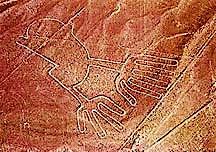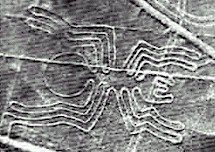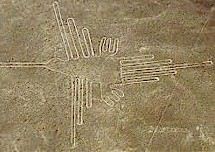 |
|
Weird being with huge hands |
 |
|
Spider |
 |
|
Hummingbird |
|
The commonly called
"Nasca Lines" made known by Toribio Mejia Xespe in 1939, are
the most outstanding
group of geoglyphs in the world. They are
not the only ones, as there are huge geoglyphs worldwide. But the Nasca geoglyphs,
because of their
numbers, characteristics, dimensions and cultural continuity, form the most impressive as well as
enigmatic archeological
group.
The concentration and
juxtaposition of the lines and drawings leave no doubt that they
required intensive
long-term labor as demonstrated by the
stylistic continuity of the designs, which clearly correspond to the
different stages of cultural changes.
The desolate plain of
the Peruvian coast comprising the Pampas of San Jose (Jumana), Socos, El
ingenio and
others in the province of Nasca, covers an
area of approximately 450 km2,
of sandy desert as well as the slopes of the contours of the Andes. There
we can find innumerable figures
of various
characteristics and sizes. The pebbles which cover
the surface of the desert contain ferrous
oxide and the exposure of centuries has given them a dark patina.
When the gravel is removed, they contrast with the color underneath. In
this way the lines were drawn as
furrows of a
lighter color, even though in some cases they became prints. In other
cases, the stones defining
the lines and drawings form small lateral
humps of different sizes. Some drawings, especially the early ones,
were made by removing the stones and gravel from their contours and in
this way the figures stood out in
high relief.
In general terms, we
can say that there are two kinds of designs: the first are figures of
various beings and
things and the others form geometric lines.
The former consist of figures of animals, plants, objects, such as
anthropomorphic figures of colossal proportions.
|